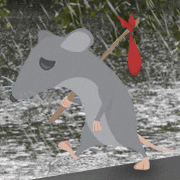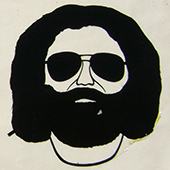|
Outrail posted:So in the space movies when they're looking out the window and there's a splash of a few dozen stars, should it instead be more like a metric poo poo ton of multicolored dots all over the place, or have they got it right? Somewhere in between, but actually it's impossible to find an image that captures this (the earth's reflected light is so bright exposure times on any picture with it anywhere in frame is going to be like you have the flash on). One of the professors here is a former astronaut; I'll have to see if he can point me to any. The atmosphere is a bitch. Everyone thinks air is transparent but holy hell it's not even close. 90% of the standard undergraduate "methods and instrumentation" course in astrophysics is about the atmosphere, particularly the concept of "optical depth". Basically, light passing through material able to interact with it (absorb, scatter, reflect, etc) will decrease its intensity exponentially. That exponent is a complicated function of the opacity (itself dependent on wavelength, composition, etc) and density of the air column. So in space, "optical depth" is basically zero from that star's surface to your face (something something interstellar medium, but it's not really important in visible wavelengths). The difference between sea level and Everest is WAY more significant, since ~75% of our atmosphere's mass is in the swampy troposphere, which Everest is basically RIGHT at the cusp of leaving. Even though the physical distance from there to orbit is still way greater than sea level to there, that attenuation exponent (optical depth) is going to be way smaller since the density is so small (and composition is a bit different, temp and pressure.....look, atmospheric physics is complicated and oh god what am I doing with my life studying this  ). ).Bottom line: The starfield won't look super different in orbit compared to on Everest. Movies are still wrong, but it won't be this overwhelming tapestry of colored dots. There are still only a limited number of stars bright enough to be seen by the naked eye, even in space, mostly because they're all farther away than the human brain can comprehend. Fun side note: In that class, on an exam, we had to calculate the energy flux into your eye for pressing it against a red hot stove element versus staring at the sun. Guess which is safer (in terms of net energy flooding your eye and trying to boil it).
|
|
|
|

|
| # ? Apr 23, 2024 21:19 |
|
Unless you're trying to take a picture of stars, there probably won't be any in the final image. People claim the moon landings are fake because there are no stars in the pictures. In reality, the moon is so bright, there's no way to take a picture that has a clear image of the surface as well as the stars in the sky.
|
|
|
|
The place that deserved the most ridicule was Lake Louise. I couldn't find a good photo with the outlet stream totally frozen so you'll have to make do with this. Of course, no one climbs Everest in the dead of winter so here you are at the lake during a more appropriate season. 
|
|
|
|
I'm so glad I'm still following this thread.
|
|
|
|
BaronVonVaderham posted:More star poo poo
|
|
|
|
On my way back to Namche, still somewhat alive just damned tired of eating Dal Bat. Bonus pic of Ama dablam at night:
|
|
|
|
elwood posted:On my way back to Namche, still somewhat alive just damned tired of eating Dal Bat. Bonus pic of Ama dablam at night:
|
|
|
|
Outrail posted:So what if I'm chilling out in the inky blackness of interstellar space, halfway to alpha centuri. Then will it be an amazballs starscape in all directions? Nope. Everything's still so far away. The number of stars visible to the naked eye won't change. The closest you'll get to that sort of view would be really close to the galactic core, but you'd probably die for so many reasons before you could enjoy it.
|
|
|
|
elwood posted:On my way back to Namche, still somewhat alive just damned tired of eating Dal Bat. Bonus pic of Ama dablam at night:
|
|
|
|
BaronVonVaderham posted:Nope. Everything's still so far away. The number of stars visible to the naked eye won't change. So why are the stars more impressive at Everest than in outerspace, or are you saying that top of Everest type mountains is the pinnacle of amazeballs we're getting? I'd totes say that the mountain range level lights qualify as amazeballs.
|
|
|
|
Oracle posted:Are those streaks comets or airplanes or shooting stars or what Camera jiggle. Could be from manually hitting the shutter button instead of using a remote or having auto-stabilization on. I get them in my photos too because I'm cheap and forget to turn stabilization off.
|
|
|
|
Back in Namche. This concludes my "epic" story of a german tourist on his way to ebc and back. All the struggles I...my porter had to endure to get my poo poo up to 5200m. All my near death experiences from heart attacks when I learned the prices of coke ($5), chocolate bars. ($2.50) and pringles ($6.50) up high and last but not least all the frustration of having lovely internet. I hope some of you have enjoyed the pictures. If not, tough poo poo. If anyone wants to follow my groundbreaking trip in the future, I'm more than happy to answer questions with my vast 14 day nepal hiking experience.
|
|
|
|
See that's one thing I don't think I'll ever get. If I don't carry all my own poo poo then I just don't get to go. I couldn't imagine hiring human beings to be my pack mules. If you're not self-sufficient then you should just stay the hell home.
|
|
|
|
Terrible Opinions posted:So why are the stars more impressive at Everest than in outerspace, or are you saying that top of Everest type mountains is the pinnacle of amazeballs we're getting? I'd totes say that the mountain range level lights qualify as amazeballs. It's not the location but the exposure time. Elwood set the exposure time so a lot of light could hit the sensor. More light than your eye would be able to gather.
|
|
|
|
Picnic Princess posted:See that's one thing I don't think I'll ever get. If I don't carry all my own poo poo then I just don't get to go. I couldn't imagine hiring human beings to be my pack mules. If you're not self-sufficient then you should just stay the hell home. Thats one valid way to see it, the other is that the country depends on tourists and especially after last years earthquake people are more than happy about every single tourist that puts money into the economy.
|
|
|
|
elwood posted:Back in Namche. This concludes my "epic" story of a german tourist on his way to ebc and back. All the struggles I...my porter had to endure to get my poo poo up to 5200m. All my near death experiences from heart attacks when I learned the prices of coke ($5), chocolate bars. ($2.50) and pringles ($6.50) up high and last but not least all the frustration of having lovely internet. I hope some of you have enjoyed the pictures. If not, tough poo poo. Did you notice any difference in taste? Did you eat Yak? what does it taste like? Yak-milk? Yak-cheese?
|
|
|
|
Dr Sun Try posted:Did you notice any difference in taste? I took diamox so carbonated stuff tasted flat. Actually I just ate yak steak. Tasted like normal lean steak. Other than that we had yak butter in the morning.
|
|
|
|
Picnic Princess posted:See that's one thing I don't think I'll ever get. If I don't carry all my own poo poo then I just don't get to go. I couldn't imagine hiring human beings to be my pack mules. If you're not self-sufficient then you should just stay the hell home. We paid a woman to make her donkey carry our packs up an incline once because my friend had a busted ankle. I don't know where I'm going with this.
|
|
|
|
Terrible Opinions posted:So why are the stars more impressive at Everest than in outerspace, or are you saying that top of Everest type mountains is the pinnacle of amazeballs we're getting? I'd totes say that the mountain range level lights qualify as amazeballs. Cojawfee posted:It's not the location but the exposure time. Elwood set the exposure time so a lot of light could hit the sensor. More light than your eye would be able to gather. They're only more impressive than sea level. Not only does he probably have a truly dark sky (never forget the first time I experienced that in Curacao....I grew up in NY where no one knows what stars are, the sky there just kind of glows vaguely red all the time), but that is about as good as it gets in terms of clarity and lack of atmospheric absorption. There isn't much improvement in orbit, at least for visible wavelengths. This is why the best ground-based observatories are in the mountains....Keck on Mauna Kea, LSST and so many others in the Andes, etc. That said, the photo is not indicative of what you would see with your eyes because yes, the exposure time is long. A photo taken in orbit won't capture the stars well because you either have the super bright earth or moon in frame (so you have a super fast shutter, like if you had the flash on) or, if you're in the dark and set the exposure long, you're moving even more in orbit than you would be on the ground (and try holding a camera steady in zero-g....space-based telescopes have insane stabilization systems). Picnic Princess posted:Camera jiggle. Could be from manually hitting the shutter button instead of using a remote or having auto-stabilization on. I get them in my photos too because I'm cheap and forget to turn stabilization off. It's possible those are artifacts of the exposure. Unless you have your camera on a polar-aligned mount (axis is perfectly parallel to earth's, and it has a little motor that causes it to rotate at the exact same speed), the earth will rotate during the exposure. You're stationary on said earth, so it appears that the stars move. This is obvious, poo poo migrates across the sky all night, but you only really notice it in a camera that's collecting light all in one image over time. You can actually figure out the exposure time based on the length of the arcs. If you pointed the camera to the north and set the exposure SUPER long (or, past a certain point, a time lapse composite taken over the night or else you'd blow out the image), you'd see all the stars start to make circular tracks around Polaris, which will be the only "stationary" star (since it's right on the axis of rotation, vertically above the north pole.....only not 100% perfect). 
|
|
|
|
Picnic Princess posted:See that's one thing I don't think I'll ever get. If I don't carry all my own poo poo then I just don't get to go. I couldn't imagine hiring human beings to be my pack mules. If you're not self-sufficient then you should just stay the hell home. Some places simply do not allow you to, because if they did they'd all look like the first 10 miles of the Appalachian Trail littered with discarded garbage and excess gear. Having been on both sides of it (hiring a porter as required in Peru and being the guide hauling all the rope, gear, and food elsewhere), it doesn't feel degrading. They haul the important stuff so the guests can worry about things like "not walking off a cliff", "drinking water", and "breathing at elevation".
|
|
|
|
Dr Sun Try posted:Did you notice any difference in taste? You can get yak in the states. Tastes like lean beef.
|
|
|
|
Picnic Princess posted:See that's one thing I don't think I'll ever get. If I don't carry all my own poo poo then I just don't get to go. I couldn't imagine hiring human beings to be my pack mules. If you're not self-sufficient then you should just stay the hell home. Yeah I took my own pack with me on the Annapurna Circuit and after a day I got used to the weight OK. Should have some pictures up of that in a few days! Also I had yak cheese a few times while I was there and it was awesome. Price of coke sounds crazy high on EBC, on the AC it got as high as 3 dollars for a 500ml bottle but I was happy to pay that because it tasted SO GOOD after a day's hiking.
|
|
|
|
This isn't Everest related but it's about the Himalayas, so for anyone interested in other long distance Himalayan hikes here's a little summary of the Annapurna Circuit which I just came back from hiking. This is the route and length that I took, it comes in at around 110 miles. You can continue it for longer but due to time constraints and work that's when I had to stop. I think the two best things about the trek (apart from the views of the Annapurnas) are the gradual change in climate and environments, and the culture and villages you pass on the way.  It starts in the town of Besisahar about 6/7 hours west of Kathmandu by road. The first few days of the trek are in subtropical rainforest type climates in which you sweat like nobody's business. Very dense and lush vegetation.   After a few days you find yourself in pine forests and cooler temperatures. The smell of the pine is just incredible and I could have honestly spent a long time just in this part exploring and hiking around.   There are some really cool Buddhist villages and structures all over the circuit like Gompas (Monasteries), Stupas and Mani Walls.    Coming out of the pine forests as you climb higher you get to the more alpine regions which give you the first real sights of the Annapurnas. This is Annapurna II.  Cheeky panorama of the Manang Valley.  There was this awesome trail through a landslide area with some amazing rock formations.   More mountains.  Ruins of the village of Upper Khangsar dwarfed by mountains.  Then we got to Thorung-La pass which is 5416 metres high. I didn't suffer any symptoms of AMS and when I got to the top I definitely felt like I could go higher. We had spent 5 days previous to this above 4000 metres which helped in acclimatisation. It's still loving hard work walking uphill at that altitude though.   Panorama of the Muktinath Valley on the other side of the pass. This is a holy site for both Hindus and Buddhists. It's a very cool place. The landscape really changes once you're in this valley as it's in the Monsoon's rain shadow, it's much more barren compared to the other side. That bigass mountain you can see in the background above Muktinath town is Dhaulagiri, the 7th highest mountain in the world. It's a beast.  This is a great little village called Kagbeni, very old and so much character.  And then this is the place where I finished, Marpha.  If you do go to Nepal and do a trek I HIGHLY recommend going to the lakeside town of Pokhara afterwards, it's the perfect place to relax for a few days.  Honestly doing the circuit is one of the best things I've ever done, I can't rate it highly enough. I will absolutely be going back to Nepal to do others, like EBC. I've taken lots more photos if anyone else wants to check them out, the whole album is here. Bonus doggy pic! 
|
|
|
|
Great photos, thanks for sharing. If you don't mind me asking, what are the costs associated with a trip like this? I've always wanted to do something like this in the Himalayas.
|
|
|
|
Nocheez posted:Great photos, thanks for sharing. Depends where you're coming from for flights but I got return flights from London for just over £500. On the trek I was spending around £15-£20 a day because I liked to get a coke at lunch and a beer at dinner (apart from higher up) and sometimes other treats like snickers. So that's anywhere betweeen £300 and £450 for the trek itself depending on how long you spend there and how much other luxuries you like to buy on the way. A lot of places offer free board if you eat dinner and breakfast there. Then you've got to think about the stuff you bring with you like clothes and rucksacks and things but if you're on a budget you can get pretty much everything you need in Kathmandu or Pokhara for a third of the price (albeit a little worse quality). If you are so inclined you can also hire a porter to carry stuff or a guide to show you around but we didn't think they were needed for us. We heard a story of a group of Israelis who carried all their own stuff but hired a porter to carry a boombox for them and blasted music the whole way! There are also a couple of permits to pay for too but they came to like $40 in total. There are also a few days either side of the trek we had in Kat and Pok hanging around which add up a little too, with that and transport between the cities. I'd say all in for 16 days trekking with two days in Kat beforehand and two days in Pok afterwards, including flights and gear the whole thing came to about £1500. Nepal is really not an expensive country to visit.
|
|
|
|
elwood posted:If anyone wants to follow my groundbreaking trip in the future, I'm more than happy to answer questions with my vast 14 day nepal hiking experience. What is death like? Is the mountain constantly consuming and reviving your soul in the afterlife or is it more of a torture thing?
|
|
|
|
Aphex- posted:A whole lot of awesome Incredible. I really need to get my sorry rear end over there someday.
|
|
|
|
Outrail posted:So in the space movies when they're looking out the window and there's a splash of a few dozen stars, should it instead be more like a metric poo poo ton of multicolored dots all over the place, or have they got it right? A lot of good answers already, but I figure we can't talk about this without letting Neil weigh in: https://www.washingtonpost.com/blog...yZItS_blog.html Anyway, I'll add an additional wrinkle. Assuming you've never actually been to space, 100% of the images of starfields taken in space that you've seen, were photographs. And cameras (both film and digital) have an important feature called dynamic range. Dynamic range is basically a measure of how well the camera can handle a field that contains both bright and dim objects. Consider those photos (on film) taken during the Moon landings. In those, the stars are not visible. The reason is because they're photos of well-lit things: the moon itself, astronauts, the lander, etc. The light from the stars is falling onto the camera's lenses, and the film inside: but the dynamic range of a film camera is too poor to both capture the very dim stars, and the very bright objects being photographed, simultaneously. Any camera can take pictures of the stars with any film, as long as the shutter is held open long enough: but if there's a brighter object in the field of view, the light from that object will just keep adding to the exposure more and more, and eventually you just get a huge blurry pure white overwhelming glow from that bright object. A little of its light bounces around and scatters inside the camera, so you don't even see the stars. It'd just be a blown-out mess. Digital cameras use software to record the electrical signals sent by arrays of sensors (a CCD - Charge-Coupled Device). Modern CCDs and modern firmware in CCD digital cameras have become very sophisticated. The software can selectively record or ignore each impulse coming from the CCD, which means a camera can improve its dynamic range by limiting how much data is recorded in bright areas while maximizing how much data is recorded in dim areas. This is much harder than it sounds, and there are other factors at play - physical limitations of the CCD, light reflection within the lens and camera body, and so on. But the result is that you can point a digital camera at a scene containing bright foreground and dim background objects, and get a photo out the other end that is neither overexposed in the foreground nor underexposed in the background. So, the relevance of all of this is... what exactly are you supposed to be looking at, when you watch a space movie? Are you supposed to be seeing what a human observer would see, with the naked eye? In that case, any scene involving space ships (interior or exterior), people, etc. lit by much light, would have the star field be nearly invisible. Nearby or very bright stars might be visible, but your naked eye cannot accumulate data from a long exposure (well... your brain sorta does this, "remembering" what the eye just saw recently and combining it with what the eye is seeing now, which is why movies and TVs work by flashing successive images at you, but that's limited and not really the same thing) so the eye cannot discern dim stars while simultaneously dealing with much brighter objects in the same field of view. Your iris opens to let in more light when looking at dim things, but closes to protect your eye from damage when bright things are in view. It can't do both simultaneously. On the other hand, maybe what you're supposed to be looking at in your space movie, is what a digital camera would record? If the crew of the ship is looking at a viewscreen that is driven by hull-mounted cameras, the camera software and hardware may have tremendous dynamic range. It could deliberately combine bright foreground objects with dim background objects. Often though you're watching a scene as a disembodied observer - neither a character's view, nor looking at a viewscreen, but just an invisible ghost who gets to see what's going on. Should you see only exactly what a human eye could see, or more? A film-maker has a responsibility to immerse you in the scene, usually, and so the filmmaker typically shows you what you'd see if you were there - a human viewpoint. In those cases, those portholes and glass windows in the spaceship should show maybe the nearby sun or a planet or something, and possibly a handful of bright stars, but nothing else, just blackness. If the camera moved right up to a window, so you no longer saw anything but the stars, than you should see stars down to an apparent magnitude of no more than about 8. Because that's the limit of the human eyeball. Conclusion: in Star Trek, when they go to warp and you're looking at the screen on the bridge? The stars should be different colors and different brightnesses, but it's fine if they show way more stars on the screen than the human eye would see looking out a window, because the display can enhance the brightness of stars vs. whatever else is in the image. However, when characters are standing near a window and you see tons of stars out of it, that's too many stars to see. In my experience most movies get this wrong, and also show only white stars, and also don't show a good mix of bright and dim, and also show stars in a nonrandom pattern (that is, mostly evenly spread out in the field rather than unevenly clustered into bunches and groups). Leperflesh fucked around with this message at 22:32 on Nov 10, 2016 |
|
|
|
Picnic Princess posted:Incredible. I really need to get my sorry rear end over there someday. Its sooooooo worth it. I already want to go back and do EBC, The Manaslu trek and Annapurna base camp among other things. It really is a hiker's paradise.
|
|
|
|
https://www.bloomberg.com/view/articles/2016-11-10/china-tries-to-conquer-everest China is going to Alps-ify their side of Everest
|
|
|
|
That's hilarious because Europeans flock to the Canadian Rockies for its wilderness because they don't have that at home anymore.
|
|
|
|
Picnic Princess posted:That's hilarious because Europeans flock to the Canadian Rockies for its wilderness because they don't have that at home anymore. Sometimes even the Nepali side felt to crowded. We went to Base Camp via Gokyo, crossing cho la pass and did the standard route on the way back. The return part felt more or less like a crowded hiking highway with hundreds of people all over the place. Worst were the chinese groups always blocking narrow parts by just standing there and changing clothes in the middle of the trail before steep ascents. Gokyo was no barren wilderness either mind you, but it was way more relaxing and empty in comparison.
|
|
|
|
Leperflesh: bringing education I didn't know I wanted to a thread about laughing at dead hikers.
|
|
|
|
Leperflesh posted:A lot of good answers already, but I figure we can't talk about this without letting Neil weigh in: Sorry lemme be camera nerdy about this. What you've said isn't quite right - implying that modern film has a narrower dynamic range than modern digital sensors isn't correct (although film from the 60s and 70s did). Digital sensors on some cameras can capture "HDR" by exposing multiple times rapidly and combining the images - like, the RED motion cameras do this and achieve around 15 stops of dynamic range. Most pro-sumer camera sensors approach 12-ish stops of dynamic range (per exposure, not doing an HDR setting), while film reaches 13 or 14. I'm also pretty sure that CCDs don't work the way you describe, "ignoring" overexposed areas of the sensor in software. At least I've never come across a camera that can do this - and if they could you can bet they'd be putting it all over the marketing materials. Overexposure on a digital sensor results in pure white, with no color or brightness data, all 11111111's. You can see this for yourself - a camera raw file is an unprocessed dump of every bit coming from the sensor. You discard your pure white pixels (11111111's or whatever) and you have no other data to replace them with. Just flat pixels. But a wider point is that cameras don't use CCDs these days anyway because CMOS is cheaper and has over time become more efficient for most purposes. CMOS also doesn't selectively reduce the current flowing through overexposed regions though.
|
|
|
|
I've become utterly fascinated, and/or, enchanted by mountaineering as of late. I'm a useless pile of poo poo who will never manage to do it, but I love watching all the films about it that I can find. Do keep up the photos and stories, it's nice to live vicariously through others.
|
|
|
|
Wistful of Dollars posted:I've become utterly fascinated, and/or, enchanted by mountaineering as of late. I'm a useless pile of poo poo who will never manage to do it, but I love watching all the films about it that I can find. Me too. I've even spent a decent amount of time in the mountains, but as fascinated as I am, gently caress no to mountaineering. I like all of my fingers, toes, and limbs. I also like being not dead and not in situations where I could easily end up dead.
|
|
|
|
https://twitter.com/realDonaldTrump/status/638511155582005248 Unfortunately I can't figure out how you're supposed to post a tweet but Trump says he's going to revert the Denali namechange.
|
|
|
|
Syncopated posted:https://twitter.com/realDonaldTrump/status/638511155582005248 Read the comments. How does the man have any self esteem?
|
|
|
|
Outrail posted:Read the comments. How does the man have any self esteem? Guys like him just think literally everyone in the world is stupid and wrong and he's the only one who is smart and correct. The more people argue, the more it justifies his twisted version of reality.
|
|
|
|

|
| # ? Apr 23, 2024 21:19 |
|
Before Trumpchat overtakes this thread as well: https://www.youtube.com/watch?v=wBqu2p5n-o8
|
|
|




























